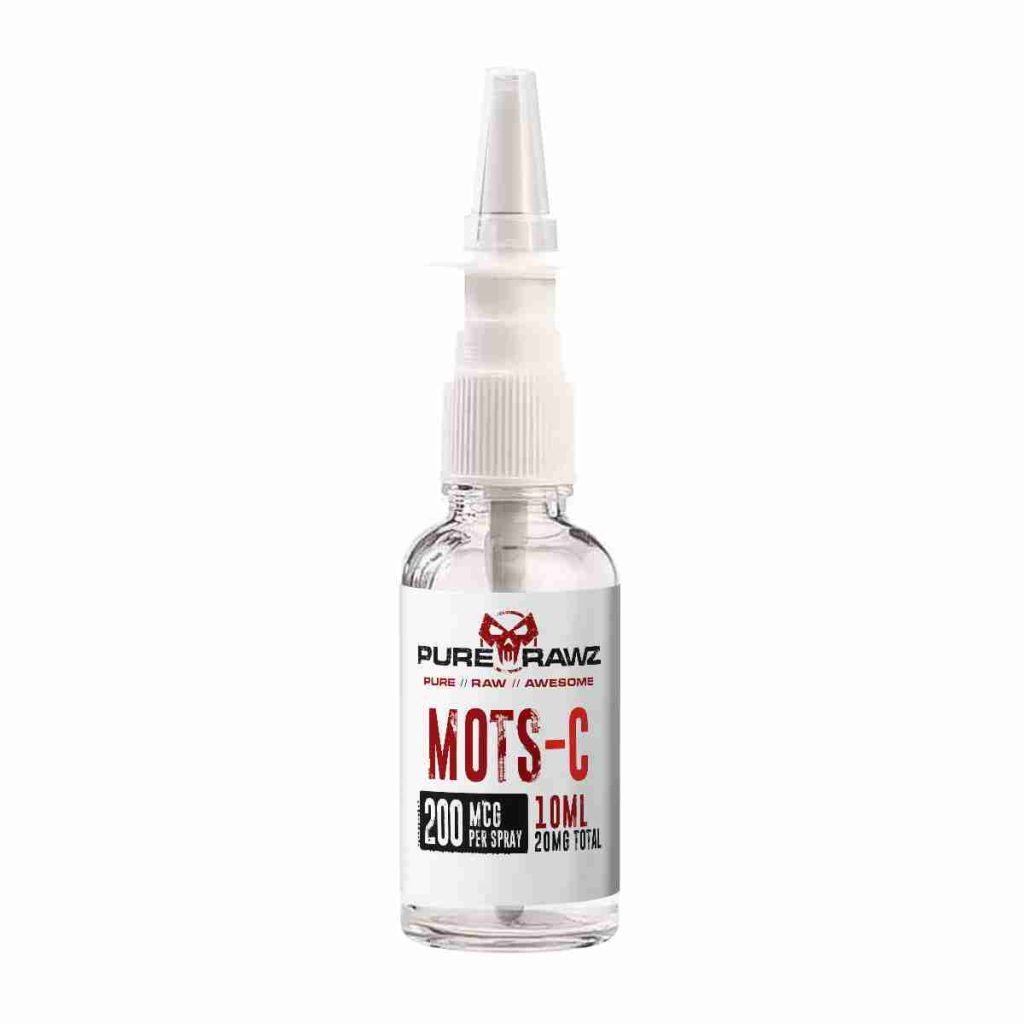Introduction
MOTS-C is an exciting new peptide encoded within the mitochondrial genome that shows great promise for improving metabolic homeostasis. Early research indicates MOTS-C can enhance insulin sensitivity, boost fat burning, increase glucose uptake in muscle tissue, stimulate mitochondrial biogenesis, and protect against obesity, diabetes, and age-related insulin resistance.
This powerful mitochondrial-derived peptide MOTS-C nasal spray provides a convenient way to supplement. Small bioactive peptides known as mitochondrial-derived peptides are created by the short open reading frame region of mtDNA, but they lack the conventional traits of protein-coding genes. In this comprehensive review, we’ll explore MOTS-C nasal sprays – how MOTS-C works, its science-backed benefits, potential side effects, legal status, dosing recommendations, and the best place to buy high quality MOTS-C nasal spray online

Product Information:
MOTS-C nasal spray contains the active ingredient Mitochondrial Open Reading Frame of the 12S rRNA-C peptide. This is a naturally occurring 16 amino acid peptide encoded within the human mitochondrial genome. Early research discovered MOTS-C is expressed in response to metabolic stress to help maintain cellular homeostasis.
Leading MOTS-C nasal spray products provide 5mg per bottle in a convenient nasal spray delivery system. The MOTS-C peptide powder is suspended in a sterile aqueous solution for efficient absorption when administered nasally. The spray allows rapid transport into systemic circulation compared to oral dosage forms.
When selecting a MOTS-C nasal spray, check independent lab reports confirming the purity and concentration of the active MOTS-C ingredient. Reputable vendors provide quality control testing for each batch.
Image Source: PubChem
How Does It Work?
Unlike most peptides, MOTS-C is expressed from the mitochondrial genome rather than nuclear DNA. This mitochondrial-encoded peptide is produced in response to metabolic dysfunction and stress to restore homeostasis.
MOTS-C appears to exert its effects primarily by activating AMPK, which acts as a master regulator of cellular metabolism and mitochondrial function. AMPK activation triggers a signaling cascade that stimulates glucose uptake, and adipose homeostasis, decreases myocardial function, improves vascular endothelial function, fatty acid oxidation, mitochondrial biogenesis, and expression of genes that regulate nuclear gene expression of metabolic processes.
Research indicates MOTS-C’s effects occur predominantly in skeletal muscle, where it enhances insulin sensitivity and glucose metabolism. MOTS-C has been shown to attenuate diabetic myocardial lesions, improve myocardial mitochondrial function, and preserve cardiac systolic responses in rodent models. It protects cardiomyocytes by inhibiting myocardial apoptosis and regulating the mitochondrial permeability transition pore.
MOTS-C also enhances endothelial function and angiogenesis, which improves vascular function in metabolic disease. This is mediated by AMPK stimulation and downstream signaling networks like extracellular regulated protein kinases.
Overall, MOTS-C appears to modulate mitochondrial metabolism, decrease mitochondrial membrane potential, affect gene expression, and activate pathways that restore metabolic flexibility and homeostasis. More human trials are needed, but MOTS-C shows promise as a regulator of systemic mitochondrial responses.
MOTS-C – Benefits
Though still an emerging area of science, studies reveal that MOTS-C treatment can provide a wide range of benefits by optimizing mitochondrial function and metabolism:

Enhances Glucose Metabolism
- Restores insulin sensitivity and glucose homeostasis in mouse models of obesity and diabetes, suggesting benefits for metabolic diseases. [R]
- Enhances glucose uptake in skeletal muscle by increasing the translocation of glucose transporter GLUT4 through AMPK activation. [R]
- Stimulates the expression of genes involved in fatty acid metabolism and adipose thermogenic activation for fat-burning effects. [R]
Protects Cardiovascular Health
- Attenuates diabetic myocardial lesions, repairs myocardial mitochondrial injury, and improves impaired cardiac systolic function and cardiac diastolic dysfunction in diabetic mice. [R]
- Prevents stress-induced cardiac injury by inhibiting myocardial apoptosis and regulating abnormal mitochondrial calcium handling. [R]
- Enhances vascular endothelial function and angiogenesis in animal models, mitigating cardiovascular complications. [R]
- Prevention and treatment of diabetic cardiac dysfunction in diabetes. [R]
- Improves metabolic and myocardial infarction responses and left ventricular diastolic dysfunction. [R]
Exhibits Anti-Inflammatory Effects
- Attenuated acute lung injury induced by LPS in mice by suppressing inflammatory cytokine production and immune cell infiltration. [R]
Extends Health Span
- Increased lifespan, insulin sensitivity, and glucose metabolism when administered to aged mice. [R]
- May prevent ovariectomy-induced metabolic dysfunction and increase bone density based on preliminary osteoblast studies. [R]
Holds Anti-Cancer Potential
- Decreased growth and metastasis of lung cancer cells/lung epithelial cells through effects on mitochondrial metabolism and gene expression. [R]
Weight Loss
- MOTS-c is very effective for reducing adiposity and preventing obesity, even in rats fed a high-fat diet. [R]
- It increases energy expenditure and improves glucose homeostasis and insulin sensitivity, aiding weight loss. [R]
- Many users report significant fat loss of 15-18% without major diet or exercise changes after MOTS-c treatment. [R]
Boosts Energy Levels
- MOTS-c increases energy levels and endurance, allowing for longer, more intense cardio exercise. [R]
- Mice treated with MOTS-c doubled their exercise capacity compared to untreated mice. [R]
Improves Insulin Sensitivity
- MOTS-c improves aging-associated, obesity-associated, and high-fat diet-induced insulin resistance. [R]
- Enhanced insulin sensitivity helps prevent metabolic disease. [R]
Promotes Mitochondrial Health
- Being mitochondrial-derived, MOTS-c enhances mitochondrial biogenesis and protects against oxidative stress. [R]
- This mitochondrial optimization prevents aging-related mitochondrial dysfunction. [R]
Increases Life Span
- MOTS-c levels naturally decline with age, but supplementing can restore youthful levels and prevent age-related disease. [R]
- A genetic variant in MOTS-c may explain the increased Japanese lifespan. [R]
Anti-Aging Properties
- MOTS-c reduces inflammation, stimulates bone formation, aids muscle strength, and protects cognition as we age. [R]
- It shows promise for preventing many age-related complications. [R]
Bodybuilding Potential
- Research on MOTS-C for bodybuilding suggests potential benefits related to its influence on metabolic processes and skeletal muscle function.
- As a mitochondrial-derived peptide, MOTS-C has been associated with insulin sensitivity and metabolic homeostasis. These factors play a crucial role in energy metabolism and muscle development. Some studies propose that enhancing insulin sensitivity may positively impact nutrient utilization and contribute to better muscle health. [R]
However, it’s essential to note that the research on MOTS-C in the context of bodybuilding is still in its early stages, and more studies are needed to understand the full spectrum of its effects.
Other Benefits
- Prevented mitochondrial dysfunction and muscle loss in disuse atrophy mouse model. [R]
- Differentially regulates fat metabolism in the liver, muscle, and adipose tissue to maintain systemic energy homeostasis. [R]
In summary, the mitochondrial peptide MOTS-c acts to preserve mitochondrial function, regulate metabolism, inhibit apoptosis, and restore homeostasis across tissues. More human research is needed, but animal studies show promising multi-system benefits relevant to metabolic, cardiovascular, inflammatory, and age-related diseases.
Side Effects
Thus far, MOTS-C peptide appears very well tolerated. Human trials are still limited, but no adverse effects have been reported in research studies using MOTS-C.
Some hypothetical side effects could include:
- Hypoglycemia – MOTS-C may increase insulin sensitivity and glucose uptake, requiring reduced diabetes medication.
- GI distress – Nasal sprays may cause nausea, constipation, diarrhea, etc.
- Joint pain – Some users of peptides report joint discomfort.
Appropriate dosing and cycling of MOTS-C spray will minimize any potential side effects. Those taking diabetes meds may need glucose monitoring. Always consult a doctor before using any new peptide.
MOTS-C: Is It Legal?
MOTS-c peptides currently occupy a legal gray area in many countries. As research chemicals and investigational compounds that have not undergone full regulatory approval, MOTS-c peptides are largely unregulated. In the United States and some other countries, it may technically be legal to purchase MOTS-c peptides for research purposes. However, using MOTS-c as a supplement or drug for personal use likely falls outside of legal boundaries and regulatory approval channels.
There are no long-term human trials demonstrating the safety of MOTS-c supplementation. Any personal use carries unknown health risks. Selling and marketing MOTS-c for human consumption also skirts illegal territory without proper approvals. While regulatory agencies like the FDA have not imposed restrictions yet, they could decide to regulate MOTS-c peptides if concerns emerge. Given the uncertain legal status and lack of safety data, caution is warranted in considering obtaining or using MOTS-c as a supplement.
The legal risks and health implications are currently unpredictable. Until MOTS-c goes through proper regulatory procedures and approval processes, its use exists in a gray legal area and could be considered illicit without proper research contexts.
Suggested Dose:
Human trials are still lacking for MOTS-C, so no ideal dose has been established clinically. Based on animal studies, common dosing protocols suggest 100-300mcg per day divided into multiple doses.
It’s smart to start low at 100mcg and assess tolerance based on your body weight before increasing the dose. Split doses throughout the day are recommended due to MOTS-C’s short half-life. On/off cycling is advised, such as 5 days on, and 2 days off.
While more human data is still needed, these MOTS-C nasal spray dosing guidelines are generally reported as safe and effective based on anecdotal accounts thus far.
Where Can I Buy Online?
PureRawz stands out as the premier place to buy high-grade MOTS-C nasal spray online. Every batch comes with a Certificate of Analysis from an independent lab confirming purity and concentration.
Their competitive pricing gets even better for bulk orders. PureRawz ships worldwide from the USA accepts crypto payments, and runs regular sales. For reliably pure MOTS-C spray, PureRawz is my top recommendation.

Conclusion:
Emerging research on MOTS-c peptides reveals promising effects on metabolic and myocardial responses. Studies show MOTS-c impacts diabetic myocardial ultrastructure, differentially expressed genes, and metabolism in mouse skeletal muscle cells. It appears to control mitochondrial homeostasis, fatty acid metabolic process, and amino acid sequence in skeletal muscles. MOTS-c treated mice display improved diabetic myocardial structure.
This unique peptide affects mitochondrial metabolism, regulates metabolic homeostasis, enhances mitochondrial oxidative capacity, increases mitochondrial biogenesis markers, preserves cardiac systolic function, and improves vascular endothelial function compared to untreated cardiac tissue.
As a peptide that may address mechanisms underlying metabolic disease, MOTS-c shows potential for regulating endothelial cell angiogenesis, decreasing mitochondrial membrane potential, reducing myocardial ischemia-reperfusion injury, improving mitochondrial morphology, lowering mitochondrial ROS production, activating protein kinase B signaling, and controlling the human mitochondrial transcriptome. Overall, MOTS-c regulates mitochondrial function and homeostasis while improving mitochondrial morphology.
However, more rigorous human trials are still needed to fully validate efficacy and safety. When used appropriately under medical supervision and obtained from reputable sources, MOTS-c nasal sprays may provide a promising way to harness the metabolic and cardioprotective potential of this peptide. For a high-quality MOTS-c product, PureRawz offers a trusted option. But work closely with your physician when supplementing to carefully assess your individual needs.

